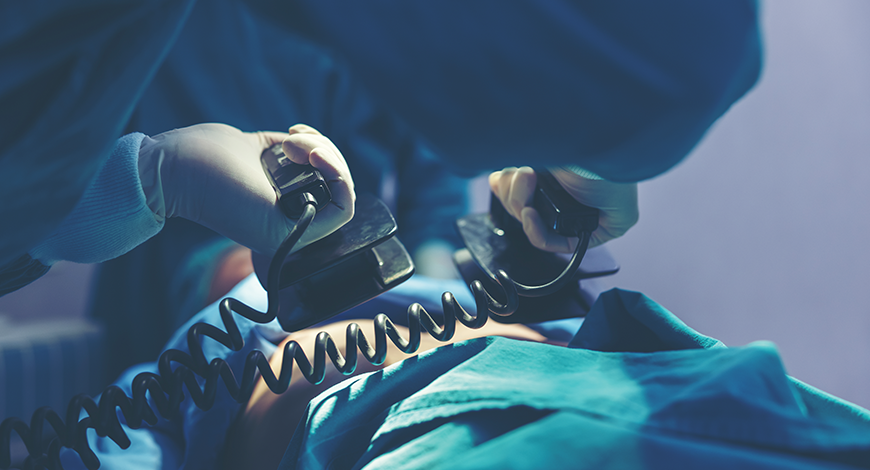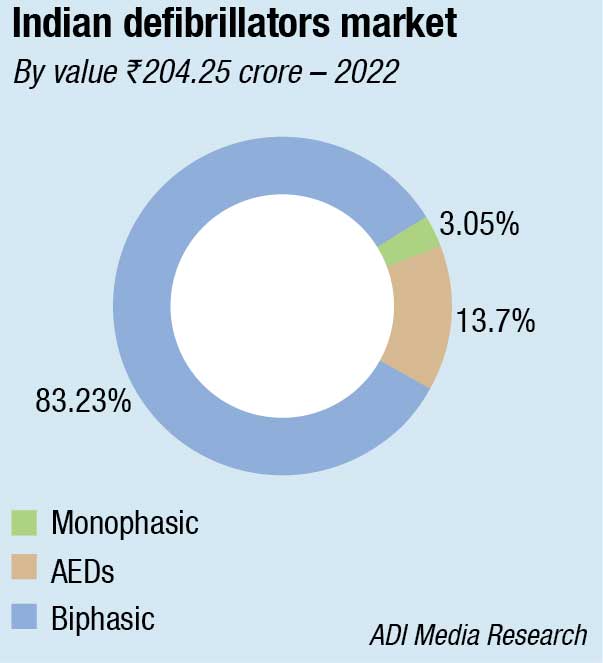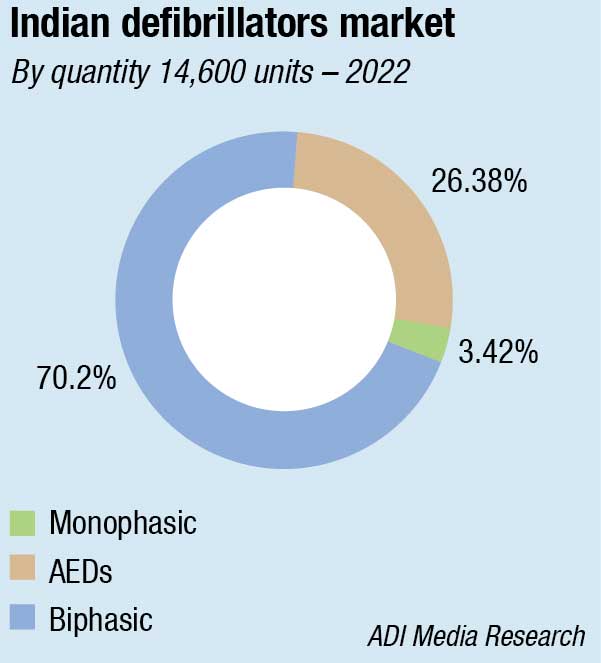Defibrilators
Making the difference between life and death

After the Covid-19 downturn, as the hospitals resumed elective surgeries, 2022 saw the defibrillator market improve.
Defibrillators can make the difference between life and death in many emergencies involving heart. The defibrillator can restore normal heart rhythm in patients experiencing cardiac arrhythmias. Defibrillators deliver an electric shock to the heart, which facilitates stopping the abnormal heart rhythm and allowing for the heart to resume its normal function.
Indian market
Covid-19 pandemic impacted the purchasing capacities of hospitals, specifically small-scale hospitals, due to shift in focus toward buying resources to take care of patients infected with Covid-19. This led to cancelled or postponed deals for defibrillators. Many public and private organizations stopped or postponed the activities of installation of defibrillators at public places due to possibility of cross-contamination and lockdown measures implemented by governments.
However, since 2022, the defibrillator market is back on track, and it is expected to grow at a CAGR of 8.1 percent over the next five years. Several public health schemes introduced by the government, and rising heart disease prevalence rates in India, are the major factors contributing to the defibrillator market.
According to the NCRB, there was a 22-percent increase in deaths due to heart attacks in India during 2017 to 2021, whereas from 2012 to 2021, there had been a 54-percent increase in heart attack deaths in India.
The defibrillator market is growing as a result of the increased emphasis on and accessibility of defibrillators at workplaces, schools, shopping centers, supermarkets, and airports. A few other factors include the increased focus of key market participants on public access defibrillators and the rise in the number of training and awareness programs worldwide.
India is presently the largest importer of defibrillators in the world, followed by Vietnam and Brazil. In FY23, India imported 35,824 units, mostly from the UK, followed by Vietnam with 1283 units and Brazil with 1210 numbers.
Indian market dynamics
The Indian defibrillators market in 2022 is estimated at ₹204.6 crore, and 14,600 units. In India, the monophasic models are being edged out by biphasic defibrillators; 2022 saw a drastic fall from 950 units of monophasic models in 2021 to 500 machines in 2022. This trend is expected to continue. The vendors too are losing interest in this segment.

The biphasic market is gradually seeing consolidation. The Make in India segment constitutes almost 30 percent, of the market and is dominated by Schiller and BPL. In the balance imported segment, three brands, Nihon Kohden, Philips, and Mindray have cornered 30 percent of the segment. Beijing M&B, Medion, Comen, Physio, and Zoll are the other visible brands.

In the AED segment, Philips lost its market share to Beijing M&B and Zoll. Schiller was also aggressive. 2023 looks more promising with many state government tenders due for finalization.
|
Leading players 2022 |
|
| Segment | |
| Monophasic | BPL, UNI-EM, and Schiller and regional, local brands |
| Biphasic | Imported- Nihon Kohden, Philips, Mindray, Comen, Zoll, Mediana, and Beijing M&B. Indian Schiller & BPL |
| Automatic external | Beijing M&B, Zoll, Philips, Schiller, and Nihon Kohden |
| ADI Media Research | |
Global market scenario
The global market of defibrillators is valued at USD 12 billion in 2022, expected to grow at a compound annual growth rate (CAGR) of 7.2 percent from 2023 to 2030 to reach an impressive revenue of USD 20.8 billion, according to Grand View Research.
2019 and 2020 witnessed negative growth rate of 7.2 percent because of postponement of cardiovascular procedures. But this downturn was only temporary. The market improved as the hospitals resumed elective surgeries.
The lifesaving necessity of automated external defibrillators in private and public spaces
 Bhavin Govindia
Bhavin Govindia
Asst. Vice President – Institutional Sales,
Schiller Healthcare India Pvt. Ltd.
In a world where medical emergencies can strike unexpectedly, having immediate access to life-saving devices can be the difference between life and death. The automated external defibrillator (AED) has the potential to save countless lives and significantly improve survival rates in emergency situations.
AEDs in private and public transportation – Modern transportation systems often expose individuals to the risk of sudden cardiac arrests. Having AEDs readily available on airplanes, trains, buses, and ships is crucial. Airports, railway stations, and bus terminals are busy hubs where the risk of cardiac emergencies, such as sudden cardiac arrest (SCA), is high. Immediate access to AEDs enables prompt response and potential lifesaving intervention. Trained staff and passengers can quickly use these devices, providing critical care until medical help arrives.
AEDs in public access areas – Public parks, gardens, buildings, shopping malls, super markets, and gyms are frequented by people from all walks of life. The risk of sudden cardiac arrest (SCA) is not limited to any particular age group or health condition. Placing AEDs in these areas ensures rapid response in case of emergencies and extends a safety net to those who might experience cardiac arrest unexpectedly. The simplicity of AED operation makes it possible for bystanders to administer lifesaving care even without prior medical training via clear visual and audio instructions to guide responders through the process.
Prompt response and increased survival rates – Sudden cardiac arrest (SCA) can occur without warning, and survival rates drop significantly with each passing minute. Having AEDs in easily accessible locations allows for a rapid response before emergency medical services arrive. Studies have shown that early defibrillation, combined with CPR, can increase survival rates by up to 75 percent or more. The immediate intervention that AEDs offer can stabilize the heart’s rhythm and improve the chances of a successful recovery.
In conclusion, the widespread availability of AEDs in private and public transportation and public access areas is crucial for saving lives in cases of sudden cardiac arrest. Their ease of use, combined with prompt intervention, significantly increases the chances of survival and fosters a safer environment for everyone.
Increasing product developments, rising incidences of sudden cardiac arrest, growing awareness among the public, and supportive initiatives by governments and healthcare organizations are some of the key factors fueling the growth of this market. Close to half of all deaths from cardiovascular diseases can be accounted by sudden cardiac arrests. The growing focus on public access defibrillator (PAD) by the public and private organizations too fuel the market growth for defibrillators.
North America continues to account for the largest revenue share of more than 35 percent of the global defibrillators market. Asia-Pacific is the region, which is expected to expand at the fastest CAGR of 8.1 percent over the next five years. This is owing to developing healthcare infrastructure, high patient population, and prevalence of cardiac diseases. The regional growth is spearheaded by the Japanese market owing to the high penetration of defibrillators and supportive policies.
AEDs show huge potential
ICDs dominated the global defibrillator market last year. However, the market potential of AEDs cannot be discounted. The global AED market was valued at USD 717.52 million in 2023, projected to register a CAGR of 9.4 percent over the next five years, says a Mordor Intelligence report.
It is slightly surprising and disappointing that even today, the manual external defibrillators segment dominates the external defibrillators market and accounted for the largest revenue share of more than 35 percent in 2022.
Hospitals are the largest market segment for defibrillators. This is because of the huge number of cardiac patients who come in hospitals and heart surgeries performed in hospitals. Both ICDs and external defibrillators are now experiencing increasing application in hospitals.
The increased number of home care settings because of the Coronavirus pandemic has also generated revenue streams for MedTech companies operating in the defibrillator market.
However, the public access segment is anticipated to register the fastest growth rate of about 10 percent due to the rising initiatives to increase the availability of public access AEDs, train personnel, and improve response to sudden cardiac arrest events.
Technological developments
There is no denying the fact that defibrillators have come a long way since they were first implanted in 1980. Consistent improvements in defibrillation technologies, especially the approval of implantable cardiac defibrillators and handheld devices, is expected to bolster the defibrillator market. Now the advances of ICD technology have made it safer and effective to prevent SCD and treat HF in both ICM and NICM.
Development of smart defibrillators. Advanced defibrillators with integrated sensors and software have been developed to provide real-time monitoring of patients and improve treatment outcomes.
Integration with telemedicine. Defibrillators are increasingly being integrated with telemedicine systems, allowing remote monitoring and consultation with medical professionals.
Regulatory approvals for new products. Several new defibrillator products have been approved by the regulatory bodies, such as the US FDA and the European Union’s CE marking, expanding the range of options available to healthcare providers.
Increased focus on home defibrillators. With the growing trend toward home-based healthcare, there is an increasing focus on developing defibrillators that can be used safely and effectively in home care settings.
Increase in focus on connected devices among MedTech companies in the global defibrillators market is augmenting the launch of portable automated external defibrillators, integrated with cellular and Wi-Fi connectivity and equipped with GPS technology. These technologies enable remote maintenance of devices and transfer of data to emergency medical service (EMS) and medical professionals, thus leading to timely response in life-threatening emergencies (life-threatening arrhythmias in particular).
The role of AI in defibrillation is expected to gain prominence in the future. AI can also be used to diagnose the causes of heart attacks, classify heart rhythms without interrupting cardiopulmonary resuscitation (CPR), and predict the success of defibrillation. The wearable cardioverter defibrillator (WCD) is an important tool in mitigating sudden cardiac death (SCD).
A UK-based study recently published by the British Medical Association found AI could eventually increase ICD speed, and reduce the number of inappropriate shocks, leading to improved quality of life for patients. Even small improvements could save hundreds of lives, the study said.
There are multiple potential benefits to the prediction of successful defibrillation. Currently, shocks are delivered, depending on rhythm assessment, following 2 min of CPR. This resuscitation protocol does not consider the likelihood of shock delivery being successful at any point during the arrest. AI algorithms can be used to predict likelihood of shock success in the hope that shocks could be delivered at the optimum time.
However, ICDs and other medical devices currently use a simpler form of AI, called rule-based AI, which cannot adapt well to an individual patient’s needs. But machine-learning-based AI can learn the hidden patterns and features from a patient’s data automatically, and has the potential to greatly improve accuracy and reduce delays.
Machine learning remains a promising new technology for SAAs in AEDs and ICDs. These technologies have the potential to increase survival in OHCA by removing the need to stop CPR during resuscitation and optimum timing of shock delivery. They can also be used to help diagnose the cause of arrest, for example, previous MI and improving patient’s quality of life by reduction in inappropriate ICD shocks – all of which could have life-changing outcomes for patients. Even small improvements in sensitivities and specificities of these widely used defibrillators could save hundreds of lives.
Although machine learning in ICDs has enormous potential, there are some limitations, including high processing power and cost. While these technologies are exciting areas of research, there remain limitations to their widespread use including high processing power, cost, and the black-box phenomenon. When the technology is more mature, more medical devices will overcome these stringent resource constraints and be driven by advanced AI algorithms.
AED delivering hope of life in sudden cardiac arrests
 Amit Kumar
Amit Kumar
Product Manager, Emergency Care-PMLS,
Mindray
Sudden cardiac arrest (SCA) is a major cause of death around the world. We have lost many lives in the past due to SCA, and the trend of losing lives due to SCA is increasing in recent times at common places like offices, gyms, etc. In times of cardiac emergencies, every second counts. That is where automated external defibrillators (AEDs) come into play. These portable devices are designed to deliver electric shocks to the heart, helping to restore its normal rhythm.
Sudden cardiac arrest (SCA) is an abrupt and unexpected loss of heart function. AEDs have revolutionized the way we respond to SCAs, which are a leading cause of death worldwide, and immediate intervention is crucial for survival. Their ease of use makes them accessible to both trained medical professionals and even bystanders with minimal training.
AEDs are designed to be user-friendly, with clear voice and visual prompts that guide the user through the defibrillation process. When turned on, the AED provides step-by-step instructions on where to place the electrode pads on the victim’s chest. If a shock is required, the AED delivers it with a controlled electrical current, aiming to restore a regular heartbeat.
Over the years, AEDs have become increasingly accessible to the public. They are now found in a variety of locations, including schools, airports, shopping malls, sports arenas, and workplaces. Many organizations, communities, and governments have recognized the importance of having AEDs readily available, and they have implemented programs to ensure widespread distribution and training. Some AEDs are even equipped with remote monitoring capabilities, allowing emergency medical services to be alerted when an AED is being used. This integration with emergency response systems further enhances the effectiveness of AEDs in saving lives.
AEDs have emerged as a vital tool in the fight against SCAs. Their ease of use, combined with widespread availability, makes them indispensable in increasing the survival rates. By providing rapid defibrillation, AEDs offer a lifeline to those experiencing cardiac emergencies, giving them a fighting chance for a positive outcome. With continued efforts to expand access and raise awareness, AEDs will continue to play a crucial role in saving lives.
The defibrillators industry faces several challenges, including:
High cost. Defibrillators are expensive medical devices, and their high cost can be a barrier to access, particularly in lower-income countries and for patients with limited health insurance coverage.
Lack of skilled personnel. The use of defibrillators requires specialized training and expertise, and a shortage of skilled personnel can limit their effective use in emergency situations.
Device malfunction and maintenance. Defibrillators require regular maintenance and monitoring. Device malfunction or failure can result in incorrect diagnosis or inadequate treatment.
Regulatory compliance. The defibrillator industry is heavily regulated, with strict requirements for safety, efficacy, and quality assurance. Meeting these requirements can be challenging for manufacturers, particularly for small and medium-sized companies.
Competition from alternative technologies. Alternative technologies, such as implantable pacemakers, cardiac resynchronization therapy (CRT), and drug therapy are competing with defibrillators in the treatment of cardiac disorders.
Product recalls and liability. Defibrillators have been subject to product recalls due to safety issues, which can damage the reputation of manufacturers and lead to liability claims.
Despite the challenges that the defibrillator market has faced, moving forward there is optimism for this segment. The market will evolve in the years to come, adapting to the new realities brought about by the pandemic and the conflict.
Revolutionizing resuscitation – Exploring the latest trends in defibrillators
 Aditya Kohli
Aditya Kohli
CFO & Director – Sales,
Allied Medical Limited
Defibrillator monitor devices play a crucial role in the diagnosis and management of cardiac conditions. As technology continues to advance, the latest trends in defibrillator monitor devices focus on enhancing their capabilities, portability, and connectivity. The latest defibrillator monitor devices offer advanced cardiac monitoring capabilities, allowing for continuous monitoring of vital signs such as heart rate, rhythm, blood pressure, and oxygen saturation. These devices provide healthcare professionals with comprehensive real-time data for accurate diagnosis and treatment planning. One notable trend is the development of portable and compact defibrillator monitor devices. These lightweight devices are designed for easy transport and can be used in various settings, including ambulances, emergency rooms, and remote healthcare facilities. Their portability ensures timely cardiac monitoring and intervention.
The devices now integrate defibrillation functionality, combining monitoring and defibrillation capabilities in a single device. This integration allows for immediate defibrillation if a life-threatening arrhythmia is detected, eliminating the need for separate defibrillation equipment. Defibrillators monitor devices now feature user-friendly interfaces with intuitive touchscreens and simplified menu systems. These interfaces make it easier for healthcare professionals to navigate through various functions, access patient data, and customize monitoring parameters for individual patient needs. The latest trends in defibrillator monitor devices are revolutionizing cardiac care by offering advanced monitoring capabilities, portability, wireless connectivity, and intelligent data analysis. These advancements empower healthcare professionals to provide timely interventions, improve patient outcomes, and enhance the overall management of cardiac conditions. Manufacturers have focused on designing devices that are intuitive and user-friendly. Clear visual and audio prompts guide the rescuer through the entire process, making it easier for someone without medical training to operate the device effectively.
Companies have incorporated technological advancements to enhance their effectiveness. For example, some devices feature algorithms that analyses the heart rhythm and provide feedback to the rescuer, increasing the likelihood of successful defibrillation. Designing a simple user interface for defibrillators is crucial for facilitating the effective use of these life-saving devices.














